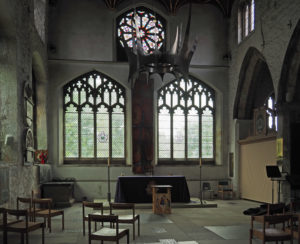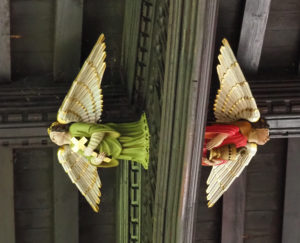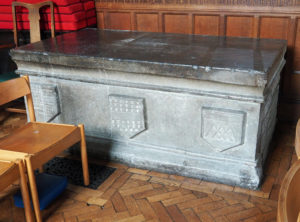Set above the banks of the River Kent on an area known as Kirkland, this is one of the largest parish churches in England. It can hold more than 1100 congregation.
There is thought to have been a church here in Saxon times and a church is mentioned in Domesday Book. The present church built in the first part of the C13th when Kendal was growing rapidly in prosperity from the wool and cloth trade. The nave was completed first, followed by the inner aisles and the tower. Much of the south aisle dates from the C15th when the church was enlarged to accommodate the Flemish weavers who arrived to start the weaving industry. The Parr chapel was added in the C15th followed by the Bellingham Chapel in the C16th, and this is now the memorial chapel for the Border Regiment, housing the colours of the 55 Westmorland Regiment of Foot. The chapel was originally separate from the church with its own entrance.
There was a major restoration in the C19th when the walls were strengthened and buttresses replaced and a west porch was added. The nave was reroofed, the box pews were replaced and the floor flagged. Stained glass was replaced and heating installed.
Entry is through the C19th porch into into the outer south aisle.
The first impression of the church is its size, with nave and two side aisles on either side.
The C15th black marble font is to the left of the door and has a splendid carved wooden cover dating from the late C19th from money raised by the ‘ladies of the church’ in memory of a former vicar.
On the outer wall of the south aisle is a modern sculpture made from fibre glass depicting ‘The Family of Man’, showing Mary and the infant Jesus as refugees with three children representing the African, European and Asian peoples of the world.
At the east end of the outer south aisle behind a cared wooden screen, is the Parr or Lady Chapel, which was the chantry chapel for the Parr Family of Kendal Castle. The tomb of Sir William Parr, grandfather to Katherine Parr is here. The coats of arms of the Parr family can be seen round the top of the walls. The reredos behind the altar depicts the Annunciation, Nativity, Crucifixion, Resurrection and the breaking of the bread.
The Strickland Chapel at the end of the inner south aisle was the memorial chapel of the Stricklands of Sizergh Castle. It contains the tomb of nine year of Walter Strickland who died in 1656, with his wrapped effigy beneath.
The nave is the oldest part of the church and feels almost small compared with the rest of the church. It now has a free standing altar to be nearer the congregation. The high altar table is C17th . The reredos behind it is made of Caen stone with polished Kendal Fell marble pillars. The niches were designed to hold statues, but this was felt to be ‘too high’ at the time.
The tiny Becket Chapel is at the end of the inner north aisle and has a very modern altar table. Pews are modern but the pew ends are C15th.
Beyond it is the Bellingham Chapel,at the end of the north outer aisle. This was added in the early C16th as a chantry chapel for the Bellinghams of Levens Hall. The practice of saying mass for the souls of the dead was discontinued during the Reformation and the chapel was opened up into the north outer aisle. This may explain the difference in roof design and heights. The corona, representing the crown of thorns, was made in 1969 in memory of Bernard Gilpin, a well renowned C16th preacher known as the ‘Apostle of the North’.
In the far corner of the Bellingham chapel is the tomb of Sir Roger and Lady Margaret Bellingham. The brasses on top are not the originals, as they were stolen in the C17th. Near it on the wall is a brass commemorating Sir Alan Bellingham who bought Levens hall in 1562.
The church is open Monday to Saturday from 10am to 4pm. There is plenty of parking by the church. It is well worth visiting.
There are more pictures “here”:https://www.sloweurope.com/community/threads/kendal-cumbria.6010/#post-38821 #4










